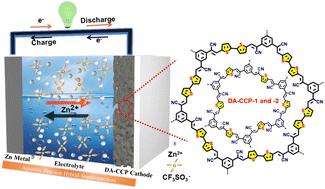当前位置:
X-MOL 学术
›
J. Mater. Chem. A
›
论文详情
Our official English website, www.x-mol.net, welcomes your
feedback! (Note: you will need to create a separate account there.)
Supramolecular engineering of cathode materials for aqueous zinc-ion hybrid supercapacitors: novel thiophene-bridged donor–acceptor sp2 carbon-linked polymers
Journal of Materials Chemistry A ( IF 10.7 ) Pub Date : 2023-01-18 , DOI: 10.1039/d2ta09651j Haijun Peng 1 , Verónica Montes-García 1 , Jésus Raya 2 , Hanlin Wang 1 , Haipeng Guo 1 , Fanny Richard 1 , Paolo Samorì 1 , Artur Ciesielski 1
Journal of Materials Chemistry A ( IF 10.7 ) Pub Date : 2023-01-18 , DOI: 10.1039/d2ta09651j Haijun Peng 1 , Verónica Montes-García 1 , Jésus Raya 2 , Hanlin Wang 1 , Haipeng Guo 1 , Fanny Richard 1 , Paolo Samorì 1 , Artur Ciesielski 1
Affiliation

|
Rechargeable aqueous zinc-ion hybrid supercapacitors (Zn-HSCs) are promising candidates as large-scale energy storage devices owing to their high electrochemical performance, safety, long life, and low price. The development of nanostructured electrode materials featuring multiple active sites capable of interacting with Zn ions represents an efficient strategy to boost their electrochemical performance. In this work, we report for the first time the use of donor–acceptor carbon-linked conjugated polymers (DA-CCPs) as cathodes in aqueous Zn-HSCs. We have synthesized two novel DA-CCPs via Knoevenagel polymerization between electron-accepting 2,2′,2′′-(benzene-1,3,5-triyl)triacetonitrile and electron-donating 2,5-thiophene dicarboxaldehyde or [2,2′-bithiophene]-5,5′-dicarboxaldehyde, yielding DA-CCP-1 and DA-CCP-2, respectively. DA-CCP-2, which possesses an extra-thiophene unit in the backbone, exhibits improved electrochemical characteristics when compared to DA-CCP-1, and performance surpassing those of other reported cathode materials for aqueous Zn2+ energy storage systems. DA-CCP-1 and -2 based electrodes exhibited an outstanding energy density of 80.6 and 196.3 W h kg−1 respectively, representing the highest value ever reached for conjugated polymers to date. This study not only offers new perspectives for the rational design and precise synthesis of DA-CCPs but it also broadens the choice of cathodes for high-performance aqueous Zn-HSCs.
中文翻译:

水性锌离子混合超级电容器阴极材料的超分子工程:新型噻吩桥接供体-受体 sp2 碳连接聚合物
可充电水系锌离子混合超级电容器 (Zn-HSCs) 具有高电化学性能、安全性、长寿命和低价格等优点,有望成为大规模储能设备。具有多个能够与锌离子相互作用的活性位点的纳米结构电极材料的开发代表了提高其电化学性能的有效策略。在这项工作中,我们首次报道了在水性 Zn-HSC 中使用供体-受体碳连接的共轭聚合物 (DA-CCP) 作为阴极。我们通过合成了两种新型 DA- CCP接受电子的 2,2',2''-(benzene-1,3,5-triyl)triacetonitrile 和给电子的 2,5-thiophene dicarboxaldehyde 或 [2,2'-bithiophene]-5,5 之间的 Knoevenagel 聚合'-二甲醛,分别产生 DA-CCP-1 和 DA-CCP-2。与 DA-CCP-1 相比,DA-CCP-2 在主链中具有一个额外的噻吩单元,其电化学特性得到改善,性能优于其他已报道的水性 Zn 2+储能系统正极材料。基于 DA-CCP-1 和 -2 的电极表现出出色的能量密度,分别为 80.6 和 196.3 W h kg -1分别代表迄今为止共轭聚合物达到的最高值。该研究不仅为DA-CCPs的合理设计和精确合成提供了新的视角,而且拓宽了高性能水性Zn-HSCs正极的选择范围。
更新日期:2023-01-18
中文翻译:

水性锌离子混合超级电容器阴极材料的超分子工程:新型噻吩桥接供体-受体 sp2 碳连接聚合物
可充电水系锌离子混合超级电容器 (Zn-HSCs) 具有高电化学性能、安全性、长寿命和低价格等优点,有望成为大规模储能设备。具有多个能够与锌离子相互作用的活性位点的纳米结构电极材料的开发代表了提高其电化学性能的有效策略。在这项工作中,我们首次报道了在水性 Zn-HSC 中使用供体-受体碳连接的共轭聚合物 (DA-CCP) 作为阴极。我们通过合成了两种新型 DA- CCP接受电子的 2,2',2''-(benzene-1,3,5-triyl)triacetonitrile 和给电子的 2,5-thiophene dicarboxaldehyde 或 [2,2'-bithiophene]-5,5 之间的 Knoevenagel 聚合'-二甲醛,分别产生 DA-CCP-1 和 DA-CCP-2。与 DA-CCP-1 相比,DA-CCP-2 在主链中具有一个额外的噻吩单元,其电化学特性得到改善,性能优于其他已报道的水性 Zn 2+储能系统正极材料。基于 DA-CCP-1 和 -2 的电极表现出出色的能量密度,分别为 80.6 和 196.3 W h kg -1分别代表迄今为止共轭聚合物达到的最高值。该研究不仅为DA-CCPs的合理设计和精确合成提供了新的视角,而且拓宽了高性能水性Zn-HSCs正极的选择范围。

































 京公网安备 11010802027423号
京公网安备 11010802027423号